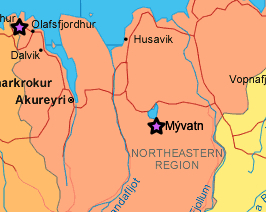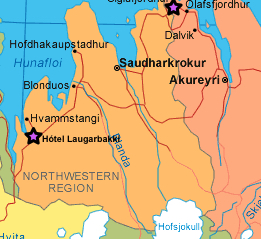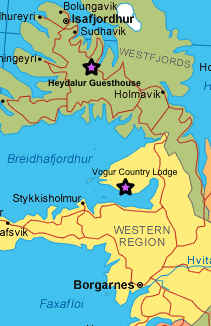Iceland 2018
I first visited Iceland in 1984. My then girlfriend (now wife) did not join me. That was a camping trip into the interior. It was an interesting trip that overlapped the trip in this page. We visited in late July so while not being 24 hr sunlight I remember watching the sun rise over the Arctic ocean at 1 AM. On that trip I discovered that in July it rains in Iceland (frequently). Since then we have joked about a "true Iceland experience" when we have to do something in the rain (like standing up eating).
The goal of the 2018 trip was to hunt the aurora. Since I run a solar program I knew that our chances for success were not good. The sun was in an abnormally quiet cycle. For many of our solar programs we had not bothered to set up the scopes. Still this offered a visit to some of my favorite areas from the 1984 trip (e.g. Mývatn) and to discover the less travelled Westfjords area. The latter was important since I had passed on several previous trips that instead went to the tourist destinations. The map on the right (below) shows where we visited.
Click on the pictures for additional commentary.
Reykjavik
I had not spent time in 1984 discovering the city. This time we specifically planned a day to walk around. Our first experience while leaving the hotel showed that this was not going to be the same weather as 1984. Fortunately, we had dressed appropriately so it was manageable.
North East
The plan was to depart from the downtown airport for Akureyri. I was looking forward to that flight since I had simulated it many times as a part of a game called "Dangerous Airports". The approach is through a canyon and then requires a last minute 45° turn. Sadly the high winds from the previous day got worse. The group correctly determined that the plane flight was not going to happen. So instead we packed off on a local bus along Rt 1 (the ring road) with the intention of meeting the bus we were supposed to get on in Akureyri. It made for a long day (even longer for the driver). As we approached Akureyri the roads had started to close. Fortunately we made it over the high pass and into the city. We continued on to Mývatn arriving about 8 PM.
After a couple of nights in Mývatn we traveled through Akureyri and then onto Siglufjörður. The snow found us again.

North West
From Siglufjörður we continued on to Hotel Laugarbakki. That was the first night the weather cleared enough to try looking for the aurora. At about 11 PM we got the knock on the door to come outside. We grabbed my camera and went out to take a couple of pictures. Soon the clouds came back. Our dedicated guide Alex stayed up, but there were no more knocks on the door.

Westfjords and West
Now it was on to the road less traveled. That was truly the case. During this part of the trip it was not unusual to not see another car for a half hour. We visited several small towns and got spectacular views across the fjords.
The first night at Heydalur Guesthouse gave us our best aurora viewing. Right after dinner the clouds cleared and a line of aurora was visible. It was relatively bright, but nearly static. I went to get my camera. I came out to something very different. For about 2 or 3 minutes the sky lit up bright enough to cast shadows. One strong burst from the sun gave us a taste for what is possible (and cured at least some of the grumbling from those who did not understand the sun cycle). Since my camera was still in my hands I decided to watch instead of snap. Good decision since it was gone as quickly as it arrived. The next hour the aurora was not as good as it was that VERY cold night in Svalbard, but even that soon faded. By 11 PM the clouds had returned. I don't remember whether even Alex gave up.
Continuing on we visited "Western Iceland" (which is actually south of Westfjords). The coastal road had great views but the wind returned. By the time we got to the Vogur Country Lodge it was "tie down loose people" weather.

Golden Triangle
The last day it was time for the tourist areas. I had visited each of these except the Blue Lagoon in 1984. Like many of the areas the government had added a lot of infrastructure in the meantime.
